WARNING: Your Emotions Could be Affecting Your Plants!
"Can Your Happiness Really Make Plants Grow Better?"
Plants are amazing!
Did you know that they become more powerful with the right amount of stress?
It's true! They toughen their leaves or produce more unique compounds ‘phytochemicals’
(those chemicals that make a plant poisonous, medicinal, or smell great).
But did you know what’s even more profound?
Plants respond to our emotional state.
They thrive when we thrive.
Unfortunately, they also suffer when we suffer.
It’s true!
I get it… you are probably thinking - ‘What the heck is this Ray guy talking about.’
It may sound cliche but love is truly the answer.
Anyone who has worked with plants long enough can start to see this truth.
I noticed this phenomena growing microgreens professionally.
(they have a fast turn over and it becomes easy to see patterns over time).
There’s just one problem however.
No one wants to acknowledge that the inverse is also true.
Your anger, sadness or pain is felt by other sentient beings.
Let’s be honest, when you feel down, it is certainly not top of mind reality.
But it’s true.
I know first hand…
Seriously.
When I farmed in straight rows planting 500-1,000x plants a week, I became robotic.
Even though I was surrounded by beauty, I eventual became miserable and my plants responded accordingly.
I was creating the very conditions leading to crop losses and disease pressure. Deep inside I had made this realization long ago. It was a self fulfilling cycle.
I just didn’t have the strength to change.
I felt tired and frustrated.
Well… sort of. I started out in great shape, physically, emotionally and spiritually.
But being driven by passion based on ideology isn’t sustainable.
I am the first to admit it. Once the ideology wore off, the passion fizzled and so did my endurance.
Working 60 hours a week with a farmer's wage is masochistic even in the best of times.
Notice the photos above vs my swollen face below.
Yeah, of course having a young family with the collective challenges we all have faced in the last few years has its toll on our health. But let’s be honest, hard work has its impact too.
Farmers know this first hand.
Why am I sharing my own struggles you may ask?
Well, many people in our shared Electroculture Beginners to Advanced Community wonder why farmers are not adopting electroculture on mass. There are a lot of skeptics out there. The truth is that I was one of those.
Farmers are pragmatic. They generally make decisions based on direct observations and have little time and resources for experimenting with fringe concepts.
Pragmatism can only get you so far however. Sometimes you need to take a plunge into the unknown and cast aside limiting beliefs.
Sometimes you have to bang your head against the wall long enough to wake up and realize it is indeed solid stone.
I certainly did.
Ask my wife, I can be stubborn sometimes even to my own detriment.
With a stroke of irony, it was that very pragmatic side of myself that got questioning all my hardened horticultural views on plants.
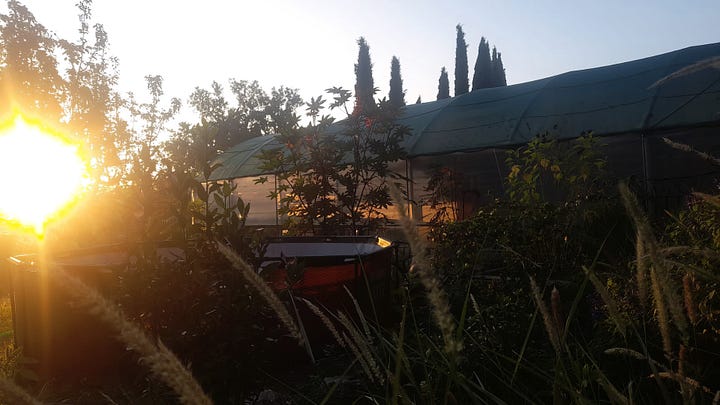

This castor bean behind our family pool grew more than 3 m tall despite being deprived of fundamental growth factors.
Every year, I plant castor beans, but last year something incredible happened.
One of my plants not only survived but thrived in the most unlikely place:
Terrible, compacted subsoil with no microbial life or extra nutrients.
Can you guess what made the difference?
This difference occurred even in spite of all my hard work with compost, manure, biochar and microbial extracts on other sections of my farm.
(I have shoveled tonnes of material over the years!)
The castor plant growing by our pool outperformed all others by leaps and bounds!
Whereas this one below was half the height and 1/3 the volume. The same was true for another set of castor beans grown in my spiral garden...
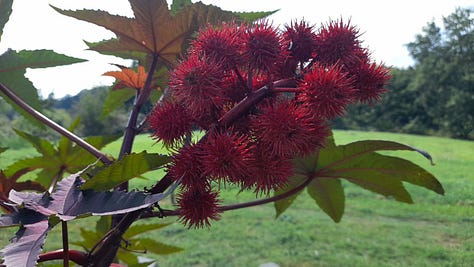
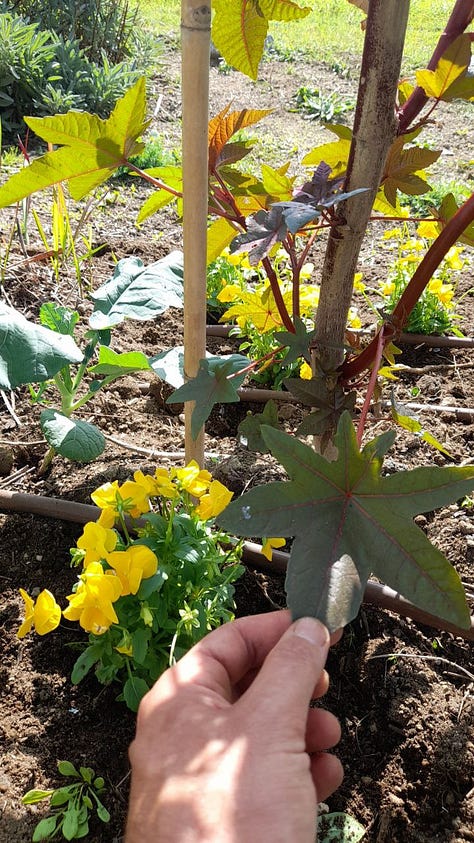
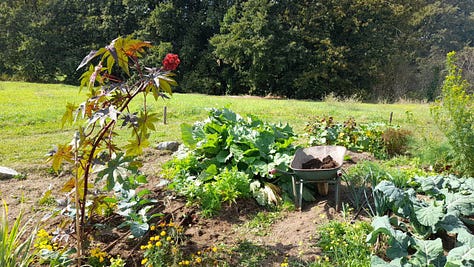
If you haven’t figured it out yet.
You are still asking why did this one plant did so well?
I have a theory that might sound a bit out there...
It was all the joy and laughter around our pool this summer.
Yes, really!
Our pool area was a sanctuary from the intense summer heat, filled with laughter, splashing, and family fun. 🏊♂️😄
Could it be that the positive energy and the constant buzz of joyful noises contributed to its growth?
It seems the vibrations from our happiness created just the right environment for this castor to thrive where no others could.
I share this message because unseen forces are influencing life all the time.
Environmental factors like sunlight, soil tilth and microbial diversity are paramount for success in the garden.
But holding love in your heart can charge seeds.
And letting go of anger can bring on the rain.
And most of the world could use more rain.
Here’s hoping for a rainbow when it's done.
In gratitude for spontaneous wisdom,
Ray Lee ‘Let the Sunshine’ Bacon
"Have you noticed how your emotions affect your garden?
Share your stories below!"
Disclaimer: This email is not intended to replace your favorite gardening techniques or therapist. While we stand by the magical properties of love and sunshine, our legal team insists we clarify that results may vary. Please plant and emote responsibly! Any plant growth spurts or unexpected rain showers are purely coincidental and by no means prove that you are sentient.
DISCOVER THE FULL STORY BELOW
The Galaxy Garden - Part 1
In this episode co-host Ray Bacon shares his experience with a growing crops on a very unique piece land, rich in energy & historical significance. A highlight of this episode is how his crops on this geographically colder piece of land significantly outperform his other crops found in much warmer local regions. Why???








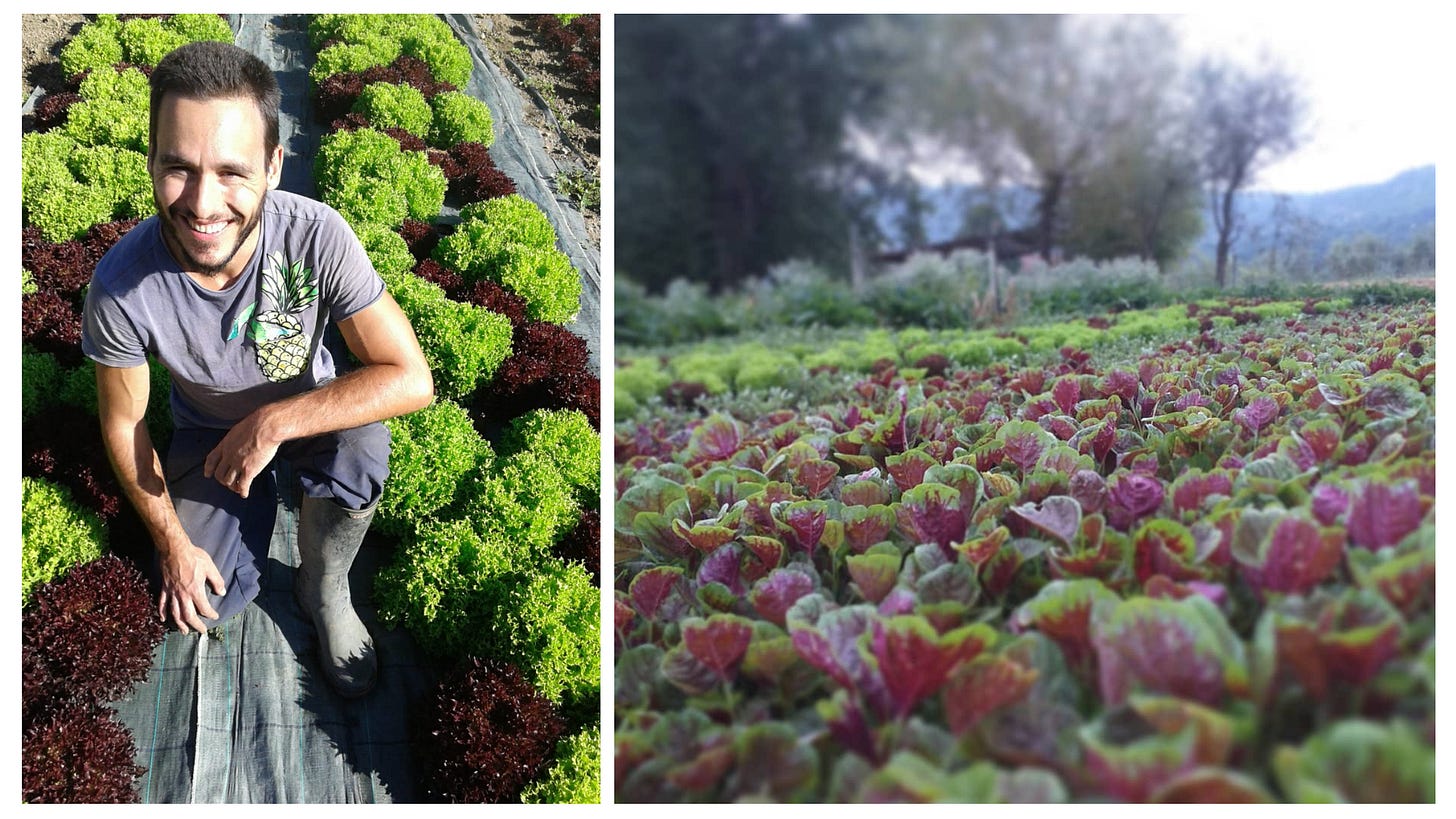

I fully agree! "The Secret life of plants" by Peter Tompkins talks about it
I know first-hand that this is true. Last year my inherited Croton started loosing leaves. The plant is at least 10-12 years old, although I've only had it for 3 years. It took me a few weeks of picking up dried, curled up leaves before I took a closer look. I found spider mites had infested the plant. I immediately took action and got rid of these pests. When I brought the plant back to the room it had been in, I put it in a slightly different area. Well, it continued to lose leaves, although at a slower rate than before. My sister felt he (I named him after the person who previously owned the plant, so...'he') was cold, so I moved him right back to the place he'd been in and put a grow light on him. I made a point to talk to him every day and told him how beautiful he is! After a few weeks, I started seeing tiny new leaves starting to grow, but that wasn't all! One of the branch tips was growing a little 'bump' which eventually turned into a flower! It's my understanding that Crotons need specific conditions to flower indoors. It never flowered at it's prior home and my living room doesn't meet those conditions. I can only conclude that my attention and care is what allowed this beautiful plant to reward me with a flower.